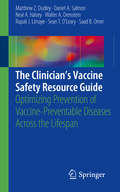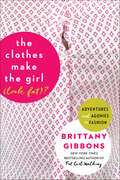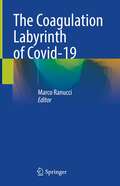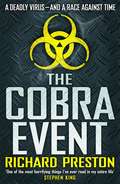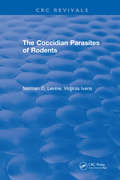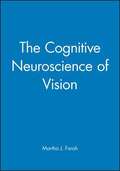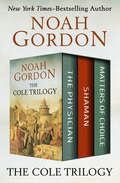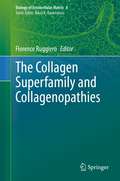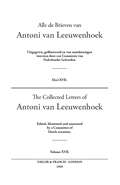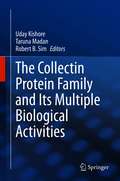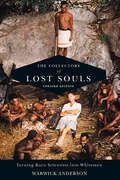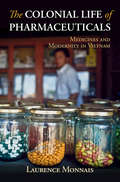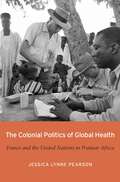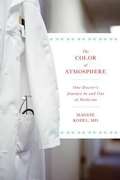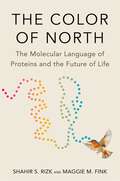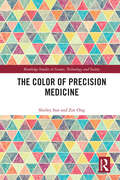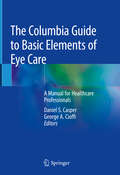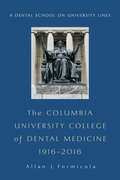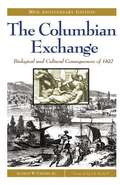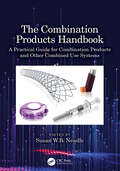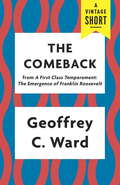- Table View
- List View
The Clinician’s Vaccine Safety Resource Guide: Optimizing Prevention of Vaccine-Preventable Diseases Across the Lifespan
by Walter A. Orenstein Matthew Z. Dudley Daniel A. Salmon Neal A. Halsey Rupali J. Limaye Sean T. O'Leary Saad B. OmerThis book provides clinicians and their staff with essential information on the vaccines that are recommended and not recommended for their patients, the diseases these vaccines prevent, and a broad range of potential vaccine safety issues that may be brought up by their patients. Each topic, from specific vaccines to safety concerns, is covered succinctly, based upon systematic reviews of the scientific literature, with talking points to be used with patients. The organization of the information makes it easy to reference specific topics and quickly find pertinent information, with the most practical details (such as recommendations and causality conclusions) highlighted at the very beginning of the respective sections. There are also sections outlining the vaccine safety system and evidence-based strategies for how to talk with patients about vaccines. This book aims to improve the efficiency and effectiveness of clinical vaccine discussions with patients, leading to more informed patients and timely vaccination. This is an ideal resource for all clinicians administering vaccines and their healthcare teams.
The Clothes Make the Girl (Look Fat)?: Adventures and Agonies in Fashion
by Brittany GibbonsA sartorial follow-up to her hilarious memoir in stories, Fat Girl Walking, internet personality Brittany Gibbons once again deep dives into the world of the plus size woman, this time chronicling her love/hate (but mostly hate) relationship with what fashion. From Pinterest boards and Instagram posts to shop windows and ad campaigns, fashion is everywhere. We shop and dress for practical reasons like job interviews or to make a good impression at the board meeting. We shop and dress for more adventurous reasons—for dates, to woo a lover, to catch someone&’s eye. Clothes are armor for women, and we wrap a lot of meaning in what we choose to wear. As plus-size spokesmodel and blogger Brittany Gibbons knows, what we choose to wear is especially important, and especially emotional, for curvy women. This isn&’t only because curvy women feel underrepresented and underserved by the fashion world. For the curvy woman who struggles with feelings of self-worth and a lack of confidence the feeling of "why bother" can come crashing in. You can&’t help but think "wouldn&’t leggings and a slouchy sweater just be easier?" Especially when we, like every other woman on the planet, are facing greater, real-life obstacles like raising kids, attending college, keeping your marriage together, paying bills, and a myriad of other daily struggles. Everyone has those days where they hate their body, they hate their clothes, but self-confidence and strength can come from a great outfit. Brittany is determined to help women, curvy and otherwise, embrace fashion and all the bumps and lumps that come with it. An "overdue love letter" to her body, Brittany delves into the hilarity and the humility of her quest to find her own personal style—to break out of a rut of maternity underwear and men&’s undershirts once and for all. From wardrobe malfunctions, to fashion advice, to mom bodies and the perfect pose, The Clothes Make the Girl (Look Fat)? is the empowered battle cry all women deserve.
The Clozapine Handbook: Stahl's Handbooks (Stahl's Essential Psychopharmacology Handbooks)
by Stephen M. Stahl Jonathan M. MeyerReal-world and clinical trial data support that clozapine is the only effective antipsychotic for treatment resistant schizophrenia and other severe mental illnesses. Clozapine also reduces rates of suicidality, psychiatric hospitalization and all-cause mortality. However, clozapine is underutilized for 2 reasons: misunderstandings of its efficacy benefits and misapprehension of, limited knowledge or misinformation about the management of treatment related risks and adverse effects. In response to worldwide efforts to promote clozapine use, this user-friendly handbook provides clinicians with evidence-based approaches for patient management as well as logical approaches to the management of clinical situations and adverse effects. It outlines clearly the rationale for specific management decisions and prioritises the options based on this logic. This handbook is designed for use by clinicians worldwide and is essential reading for all mental health care professionals.
The Coagulation Consult
by Alan Lichtin John BartholomewThere have been many changes in the field of coagulation during the past decade. New concepts of epidemiology of risk factors for thrombosis now help clinicians predict who is more likely to form clots after surgery, or after being placed on oral contraceptives. New anticoagulants have the potential to redefine how patients with atrial fibrillation and venous thrombosis are managed. There are new forms of recombinant clotting factors which have changed our approach to hypofibrinogenemia and von Willebrand's disease. Newer antiplatelet agents are available and their use in patients receiving cardiac stents has mushroomed. The management of thrombosis in the setting of pregnancy has changed over the past decade, as well as the way clinicians approach women with multiple miscarriages. An entire new class of compounds, the thrombopoietins, are available to treat individuals with immune thrombocytopenic purpura (ITP). The Coagulation Consult covers major topics of interest to hematologists who are asked to consult on individuals with coagulation related diseases, and encompasses the field's most recent developments. This "case-directed" book describes state-of-the-art approaches to patients with bleeding and clotting disorders, as well as laboratory tests for coagulation. Chapters include different vignettes, focus on typical clinical consult questions, and lay out specific types of treatment. Practicing clinicians being confronted with coagulation consult students, residents, fellows and attending physicians will find this unique text an invaluable resource for some of the newer areas of coagulation science, therapy and pharmacology.
The Coagulation Labyrinth of Covid-19
by Marco RanucciThis book is devoted to COVID-19 associated coagulopathy, one of the main determinants of mortality. The volume, intended as a guide, will lead the reader in a pathway starting from pathophysiology and passing through laboratory data, clinical aspects, imaging, and therapeutic options. Written in the middle of the second wave, the book is the first addressing the topic and summarizing the results of studies and articles meanwhile published, thus representing a unique tool for clinicians fighting the disease. The Coagulation Labyrinth of Covid-19 is intended for clinicians working with acute and sub-acute ARDS cases: intensivists, anesthesiologists, cardiologists, hematologists, who will find in it an essential guide to manage the COVID-19 pandemic.
The Cobra Event: A Novel
by Richard PrestonA deadly virus - and a desperate race against time.'One of the most horrifying things I've ever read in my entire life' Stephen KingOne spring morning in New York City a seventeen-year-old student wakes up feeling vaguely ill. Hours later she is having violent seizures, blood is pouring out of her nose, and she begins to attack her own body in the most hideous way imaginable. Soon, other gruesome deaths of a similar nature have been discovered, and the autopsies reveal that a previously unknown virus is at large. It replicates horribly fast, it is always fatal - and is just too efficient to be entirely natural.When the Centre for Disease Control sends a forensic pathologist to investigate, her discoveries precipitate a national crisis.THE COBRA EVENT is a dramatic, heart-stopping thriller of an all-too-real threat.
The Coccidian Parasites of Rodents
by Norman D. LevineThis important, long-needed revision of the authors' previous book discusses the 473 named species of coccidia of rodents. It. contains over twice as many as the 1965 book, The Coccidian Parasites (Protozoa, Sporozoa) of Rodents. Included is the available up-to-date information about each of these species. Data are given for the 99 forms which have insufficient information available to justify assigning them species names. This work can be used as a guide to future investigations, not only on rodent coccidia, but also on the coccidia of all other vertebrates and even some invertebrates. This book will serve as an invaluable and authoritative source for parasitologists. It is of importance to those involved in protozoology, tropical medicine, wildlife diseases and veterinary medicine.
The Cognitive Neuroscience of Vision (Fundamentals of Cognitive Neuroscience)
by Martha J. FarahThe Cognitive Neuroscience of Vision begins by introducing the reader to the anatomy of the eye and visual cortex and then proceeds to discuss image and representation, face recognition, printed word recognition, visual sematic memory and visual attention and perception.
The Cole Trilogy: The Physician, Shaman, and Matters of Choice (The Cole Trilogy #1)
by Noah GordonThe New York Times–bestselling author&’s historical saga of a family of healers—from Dark Ages London to Civil War America to modern-day Boston. In The Physician, an orphan in eleventh-century London, Robert Cole, becomes a fast-talking swindler. As he matures, his strange gift—an acute sensitivity to impending death—never leaves him, and he yearns to become a healer. Arab madrassas are the only authentic medical schools, and he makes his perilous way to Persia. Christians are barred from Muslim schools, but by claiming he is a Jew, he studies under the world&’s most renowned physician, Avicenna. Cole&’s journey and love for a woman who must struggle against her only rival—medicine—make The Physician a riveting modern classic. In Shaman, Dr. Robert Judson Cole, nineteenth-century descendent of the first Robert Cole, travels from his ravaged Scottish homeland, through the operating rooms of antebellum Boston, to the cabins of frontier Illinois. In the wilderness he befriends the starving remnants of the Sauk tribe, who have fled their reservation. In the process, he absorbs their culture and learns native remedies that enrich his classical medical education. He marries a remarkable settler woman he had saved from illness. The Cole family is drawn into the bloody vortex of the Civil War, and their determination to survive in the midst of wilderness and violence will stay with the reader long after the final page. In Matters of Choice, Roberta Jeanne d&’Arc Cole is the latest first-born descendant of Dr. Robert Cole. Favored to be named associate chief of medicine at a Boston hospital, she is married to a surgeon and owns a trophy residence in Cambridge as well as a summer house. But everything melts away. Her gender and her work at an abortion clinic cost her the hospital appointment. Her marriage fails. Crushed, she goes to her farmhouse in western Massachusetts, thinking to sell it, and finds an unexpected life. How she continues to fight for every woman&’s right to choose, while acknowledging her own ticking clock and maternal yearning, makes this prize-winning third story of the Cole trilogy relevant and unforgettable.
The Collagen Superfamily and Collagenopathies (Biology of Extracellular Matrix #8)
by Florence RuggieroThis book aims at providing insights into the collagen superfamily and the remarkable diversity of collagen function within the extracellular matrix. Additionally, the mechanisms underlying collagen-related diseases such as dystrophic epidermolysis bullosa, osteogenesis imperfecta, as well as collagen-related myopathies and neurological disorders are discussed.Collagens are the most abundant extracellular matrix proteins in organisms. Their primary function is to provide structural support and strength to cells and to maintain biomechanical integrity of tissues. However, collagens can no longer be considered just as structural proteins. They can act as extracellular modulators of signaling events and serve critical regulatory roles in various cell functions during embryonic development and adult homeostasis. Furthermore, collagens are associated with a broad spectrum of heritability-related diseases known as “collagenopathies” that affect a multitude of organs and tissues including sensorial organs.The book is a useful introduction to the field for junior scientists, interested in extracellular matrix research. It is also an interesting read for advanced scientists and clinicians working on collagens and collagenopathies, giving them a broader view of the field beyond their area of specialization.
The Collected Letters of Antoni Van Leeuwenhoek - Volume 16
by Drs. L. C.In volume XVI of The Collected Letters of Antoni van Leeuwenhoek, 25 letters of Van Leeuwenhoek have been included, all of them written from July 1707 to June 1712. The letters were written to six distinct addressees. The larger part was addressed to the Royal Society in London in general (sixteen letters); and to three of its fellows in particular
The Collected Letters of Antoni Van Leeuwenhoek - Volume 17
by Douglas Anderson Lodewijk C Palm Huib J. Zuidervaart Elisabeth W. EntjesThe contents of the letters published here, again show the great range of subjects that occupied Van Leeuwenhoek: from sugar candy, the shape and crystal structure of diamonds, the dissolution of silver crystals in aqua fortis to gold dust from Guinea dissolved in aqua regia and the dissolution and separation of gold, silver, and copper. Every volume in the Series contains the texts in the original Dutch and an English translation. The great range of subjects studied by Van Leeuwenhoek is reflected in these letters: instruments to measure water, pulmonary diseases; experiments relating to the solution of gold and silver; salt crystals and grains of sand; botanical work, such as duckweed and germination of orange pips; description on protozoa. blood, spermatozoa and health and hygiene, for example and harmfulness of tea and coffee and the benefits of cleaning teeth.
The Collectin Protein Family and Its Multiple Biological Activities
by Robert B. Sim Uday Kishore Taruna MadanThe topic of this book, Collectins, is a family of proteins whose major function is in innate immunity, where Collectins act as pattern recognition receptors (PRRs). In general they recognize targets such as microbial surfaces and apoptotic cells, and once bound to a target, Collectins promote the clearance of microorganisms and damaged host tissue. New cell-surface proteins and glycoproteins, which act as Collectin receptors, are currently being identified. Some Collectins, particularly MBL, activate the complement system, which enhances the ability of antibodies to fight pathogens, via three MBL-associated proteases, the MASPs. Additionally, recent research has begun to show wider-ranging activities of Collectins, such as: · Their role in metabolism, and therefore their involvement in lifestyle diseases such as obesity and cardiovascular disease.· Their ability to modulate the adaptive immune response, as well as to recognize and trigger apoptosis of cancer cells, which makes them effective in the annihilation of cancer cells with multiple mutations.· The regulation of their expression by gonadal steroid hormones implicates them with critical roles in both male and female fertility.· Altered levels of Collectins have been associated with various autoimmune diseases.This book brings together current knowledge of the structure, functions and biological activities of Collectins, to describe their integral role in human health.
The Collectors of Lost Souls: Turning Kuru Scientists into Whitemen
by Warwick AndersonThis riveting account of medical detective work traces the story of kuru, a fatal brain disease, and the pioneering scientists who spent decades searching for its cause and cure.Winner, William H. Welch Medal, American Association for the History of MedicineWinner, Ludwik Fleck Prize, Society for Social Studies of ScienceWinner, General History Award, New South Wales Premier's History AwardsWhen whites first encountered the Fore people in the isolated highlands of colonial New Guinea during the 1940s and 1950s, they found a people in the grip of a bizarre epidemic. Women and children succumbed to muscle weakness, uncontrollable tremors, and lack of coordination, until death inevitably supervened. Facing extinction, the Fore attributed their unique and terrifying affliction to a particularly malign form of sorcery.In The Collectors of Lost Souls, Warwick Anderson tells the story of the resilience of the Fore through this devastating plague, their transformation into modern people, and their compelling attraction for a throng of eccentric and adventurous scientists and anthropologists. Battling competing scientists and the colonial authorities, the brilliant and troubled American doctor D. Carleton Gajdusek determined that the cause of the epidemic—kuru—was a new and mysterious agent of infection, which he called a slow virus (now called a prion). Anthropologists and epidemiologists soon realized that the Fore practice of eating their loved ones after death had spread the slow virus. Though the Fore were never convinced, Gajdusek received the Nobel Prize for his discovery. Now revised and updated, the book includes an extensive new afterword that situates its impact within the fields of science and technology studies and the history of science. Additionally, the author now reflects on his long engagement with the scientists and the people afflicted, describing what has happened to them since the end of kuru. This astonishing story links first-contact encounters in New Guinea with laboratory experiments in Bethesda, Maryland; sorcery with science; cannibalism with compassion; and slow viruses with infectious proteins, reshaping our understanding of what it means to do science.
The Colonial Life of Pharmaceuticals: Medicines and Modernity in Vietnam (Global Health Histories)
by Laurence MonnaisSituated at the crossroads between the history of colonialism, of modern Southeast Asia, and of medical pluralism, this history of medicine and health traces the life of pharmaceuticals in Vietnam under French rule. Laurence Monnais examines the globalization of the pharmaceutical industry, looking at both circulation and consumption, considering access to drugs and the existence of multiple therapeutic options in a colonial context. She argues that colonialism was crucial to the worldwide diffusion of modern medicines and speaks to contemporary concerns regarding over-reliance on pharmaceuticals, drug toxicity, self-medication, and the accessibility of effective medicines. Retracing the steps by which pharmaceuticals were produced and distributed, readers meet the many players in the process, from colonial doctors to private pharmacists, from consumers to various drug traders and healers. Yet this is not primarily a history of medicines as objects of colonial science, but rather a history of medicines as tools of social change.
The Colonial Politics of Global Health: France and the United Nations in Postwar Africa
by Jessica Lynne PearsonJessica Lynne Pearson explores the collision between imperial and international visions of health and development in French Africa as postwar decolonization movements gained strength. The consequences of putting politics above public health continue to play out in constraints placed on international health organizations half a century later.
The Color of Atmosphere
by Maggie KozelKozel, a graduate of Georgetown University School of Medicine in 1980, spent the first 10 years of her medical career as a physician in the US military, with its universal, single-payer health coverage offering every family the same access to the latest health care. In this memoir for general readers, she recounts with warmth and humor her journey from idealistic young pediatrician to the culture shock of private practice outside the military. Her personal story is told in the context of the changing healthcare system, focusing on how the current method of paying for health care has changed the way doctors practice, not for the better. Kozel, now a high school teacher, argues that the profession is currently shaped by health insurance reimbursements and pharmaceutical marketing rather than by science. The book will be of interest to those working in the medical profession, those considering it, and general readers. Annotation ©2011 Book News, Inc. , Portland, OR (booknews. com)
The Color of North: The Molecular Language of Proteins and the Future of Life
by Shahir S. Rizk Maggie M. FinkAn awe-inspiring journey into the world of proteins—how they shape life, and their remarkable potential to heal our bodies and our planet.Each fall, a robin begins the long trek north from Gibraltar to her summer home in Central Europe. Nestled deep in her optic nerve, a tiny protein turns a lone electron into a compass, allowing her to see north in colors we can only dream of perceiving.Taking us beyond the confines of our own experiences, The Color of North traverses the kingdom of life to uncover the myriad ways that proteins shape us and all organisms on the planet. Inside every cell, a tight-knit community of millions of proteins skillfully contorts into unique shapes to give fireflies their ghostly glow, enable the octopus to see predators with its skin, and make humans fall in love. Collectively, proteins orchestrate the intricate relationships within ecosystems and forge the trajectory of life. And yet, nature has exploited just a fraction of their immense potential. Shahir S. Rizk and Maggie M. Fink show how breathtaking advances in protein engineering are expanding on nature’s repertoire, introducing proteins that can detect environmental pollutants, capture carbon dioxide from the atmosphere, and treat diseases from cancer to COVID-19.Weaving together themes of memory, migration, and family with cutting-edge research, The Color of North unveils a molecular world in which proteins are the pulsing heart of life. Ultimately, we gain a new appreciation for our intimate connections to the world around us and a deeper understanding of ourselves.
The Color of Precision Medicine (Routledge Studies in Science, Technology and Society)
by Shirley Sun Zoe OngWill genome-based precision medicine fix the problem of race/ethnicity-based medicine? To answer this question, Sun and Ong propose the concept of racialization of precision medicine, defined as the social processes by which racial/ethnic categories are incorporated (or not) into the development, interpretation, and implementation of precision medicine research and practice.Drawing on interview data with physicians and scientists in the field of cancer care, this book addresses the following questions: Who are the racializers in precision medicine, how and why do they do it? Under what conditions do clinicians personalize medical treatments in the context of cancer therapies? The chapters elucidate different ways in which racialization occurs and reveal that there exists an inherent contradiction in the usage of race/ethnicity as precision medicine moves from bench to bedside. The relative resources theory is proposed to explain that whether race/ethnicity-based medicine will be replaced by genomic medicine depends on the resources available at the individual and systemic levels. Furthermore, this book expands on how racialization happens not only in pharmacogenomic drug efficacy studies, but also in drug toxicity studies and cost-effectiveness studies.An important resource for clinicians, researchers, public health policymakers, health economists, and journalists on how to deracialize precision medicine.
The Columbia Guide to Basic Elements of Eye Care: A Manual for Healthcare Professionals
by Daniel S. Casper George A. CioffiThis unique resource is a practical, easy-to-use guide for the non-ophthalmologist healthcare provider as they encounter patients with eye complaints and other concerning ophthalmic conditions. The Columbia Guide to Basic Elements of Eye Care is specifically designed with the non-ophthalmologist in mind, and provides a foundation of basic eye anatomy and physiology, functional analysis, pathology, and concepts in eye care. Each chapter delivers an accessible summary of various ophthalmic diseases and conditions, all of which are frequently encountered in everyday practice. These chapters provide in-depth discussions on a wide range of topics, from testing and examination procedures to management protocols, referral guidelines and expected frequency of follow-up for each disorder. Complete with hundreds of high-quality, descriptive illustrations and clinical photographs, The Columbia Guide to Basic Elements of Eye Care presents clear, understandable explanations of basic eye anatomy, physiology, disease and treatment for non-ophthalmic practitioners and students. In doing so, this guide provides a framework for determining the normal versus the abnormal, helping the reader recognize which patients require referral, and identify which conditions are developing, require urgent treatment, or can be routinely followed. Non-ophthalmologist healthcare providers and students alike will find this book, written by leaders in the field, a practical resource to consult as they encounter patients with treatable but potentially sight-threatening conditions.
The Columbia University College of Dental Medicine, 19162016: A Dental School on University Lines
by Allan FormicolaIn 1916, Columbia University acquired the New York Post-graduate School of Dentistry and the New York School of Dental Hygiene and established its own College of Dental Medicine. To those working in the health sciences, the move was a powerful signal of a field on the rise. It recognized dental medicine as a key component of individual and social well-being and initiated a monumental era in medical innovation and progressive public health outcomes.This hundred-year history shares the turbulent story of dentistry, a medical field in the making. It recounts the institutional battles and research controversies that set the terms for the development and practice of dentistry. The assimilation of the dental school into the university system was not smooth. Rivalries played out in public and in private; traditionalists fought the inclusion of a young and evolving medical approach. Once the school found its footing, the College of Dental Medicine developed rapidly, and by the end of the twentieth century, had successfully launched a series of global outreach programs that immeasurably helped impoverished and underserved communities worldwide. The school's work now includes transitioning the field into the digital age and effecting even greater change in the lives of those without access to high-quality dental care. Featuring fascinating biographical details of the school's major teachers, administrators, and graduates, this book cements the reputation of Columbia University's College of Dental Medicine as a global leader in advancing the public good.
The Columbia University College of Dental Medicine, 1916–2016: A Dental School on University Lines (Columbiana)
by Allan FormicolaIn 1916, Columbia University established the School of Dentistry (now known as the College of Dental Medicine). In 1917, the university merged the school with the newly acquired New York Post-graduate School of Dentistry and New York School of Dental Hygiene. To those working in the health sciences, the move was a powerful signal of a field on the rise. It recognized dental medicine as a key component of individual and social well-being and initiated a monumental era in medical innovation and progressive public health outcomes.This hundred-year history shares the turbulent story of dentistry, a medical field in the making. It recounts the institutional battles and research controversies that set the terms for the development and practice of dentistry. The assimilation of the dental school into the university system was not smooth. Rivalries played out in public and in private; traditionalists fought the inclusion of a young and evolving medical approach. Once the school found its footing, the College of Dental Medicine developed rapidly, and by the end of the twentieth century, had successfully launched a series of global outreach programs that immeasurably helped impoverished and underserved communities worldwide. The school's work now includes transitioning the field into the digital age and effecting even greater change in the lives of those without access to high-quality dental care. Featuring fascinating biographical details of the school's major teachers, administrators, and graduates, this book secures the reputation of Columbia University's College of Dental Medicine as a global leader in advancing the public good.
The Columbian Exchange:Biological and Cultural Consequences of 1492, 30th Anniversary Edition
by Alfred W. CrosbyA closer look at the first contacts between European and American peoples and the long-term cultural effects of that encounter in both Native American and Old World European societies.
The Combination Products Handbook: A Practical Guide for Combination Products and Other Combined Use Systems
by Susan W. B. NeadleCombination products are therapeutic and diagnostic products that combine drugs, devices, and/or biological products. According to the US Food and Drug Administration (FDA), “a combinationproduct is one composed of any combination of a drug and a device; a biological product anda device; a drug and a biological product; or a drug, device and a biological product.” Examplesinclude prefilled syringes, pen injectors, autoinjectors, inhalers, transdermal patches, drug-elutingstents, and kits containing drug administration devices co-packaged with drugs and/or biologicalproducts. This handbook provides the most up-to-date information on the development of combinationproducts, from the technology involved to successful delivery to market. The authors presentimportant and up-to-the-minute pre- and post-market reviews of combination product regulations,guidance, considerations and best practices. This handbook: • Brings clarity of understanding for combination products guidance and regulations • Reviews the current state-of-the-art considerations and best practices spanning the combination product lifecycle, pre-market through post-market • Reviews medical product classification and assignment issues faced by global regulatory authorities and industry The editor is a recognized international Combination Products and Medical Device expert withover 35 years of industry experience and has an outstanding team of contributors. Endorsed byAAMI – Association for the Advancement of Medical Instrumentation.
The Comeback
by Geoffrey C. WardAn eBook short.Franklin Roosevelt contracted polio in the summer of 1921, resulting in permanent paralysis from the waist down. One year later, he went back to work. Noted historian Geoffrey C. Ward, winner of the National Book Critics Circle Award and the Parkman Prize and finalist for the Pulitzer Prize, who is himself a polio survivor, investigates the courage and character of the man who became the greatest president of the twentieth century. "The Comeback," a selection from A First-Class Temperament, the second volume in Ward's monumental biography that began with Before the Trumpet, is the story of one extraordinary man's struggle to regain his feet and reenter public life. Before his illness, FDR's political future had seemed bright. He knew that pity was poison, that if the public understood the extent of his disability his career would be at an end. Roosevelt, therefore, had to teach himself the impossible: how to walk--or seem to walk--again. This is that journey, following the future president from his disastrous attempt to return to his law office to his triumphant march down the aisle at the 1924 Democratic National Convention, where, leaning on his crutches, he delivered the triumphant "Happy Warrior" speech for ill-fated presidential candidate Al Smith and was hailed as a hero. It was FDR's new beginning.
